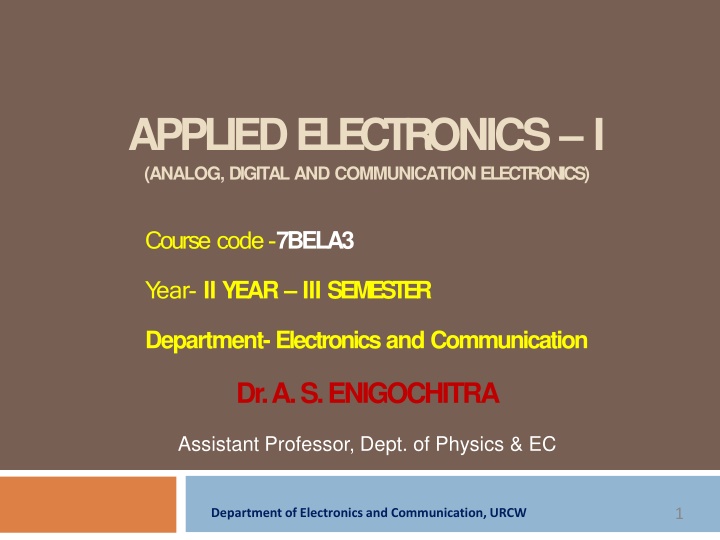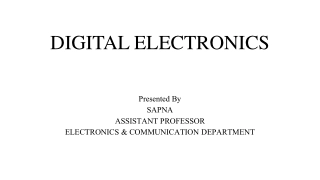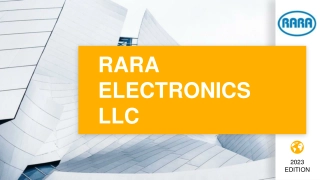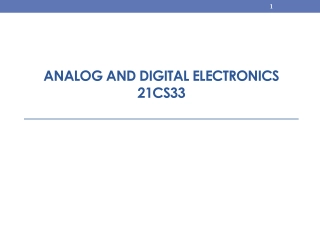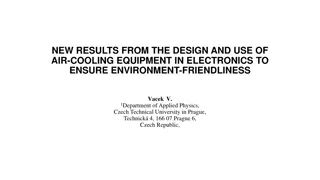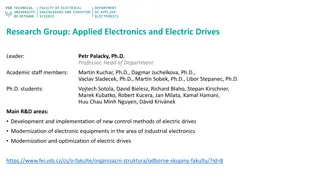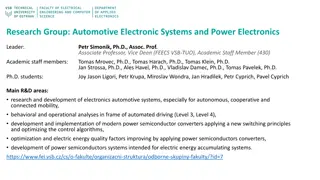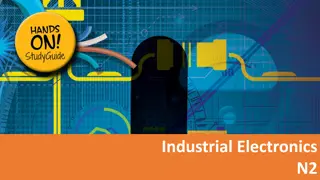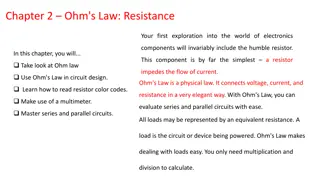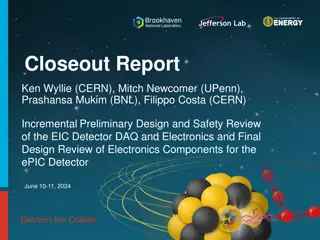APPLIED ELECTRONICS I
A diode is a fundamental two-terminal semiconductor device that allows current to flow in one direction while blocking it in the other. This course delves into the construction, working principle, and applications of diodes in electronic circuits. Learn about intrinsic and extrinsic semiconductor materials, the PN junction diode, symbol representation, and more in the realm of analog, digital, and communication electronics.
Download Presentation

Please find below an Image/Link to download the presentation.
The content on the website is provided AS IS for your information and personal use only. It may not be sold, licensed, or shared on other websites without obtaining consent from the author.If you encounter any issues during the download, it is possible that the publisher has removed the file from their server.
You are allowed to download the files provided on this website for personal or commercial use, subject to the condition that they are used lawfully. All files are the property of their respective owners.
The content on the website is provided AS IS for your information and personal use only. It may not be sold, licensed, or shared on other websites without obtaining consent from the author.
E N D
Presentation Transcript
APPLIED ELECTRONICS I (ANALOG, DIGITAL AND COMMUNICATION ELECTRONICS) Course code -7BELA3 Y ear- II YEAR III SEMESTER Department-Electronicsand Communication Dr. A. S. ENIGOCHITRA Assistant Professor, Dept. of Physics & EC 1 Department of Electronics and Communication, URCW
Unit I Diodeand ItsApplications 2 Department of Electronics and Communication, URCW
Diode Di = Two, and Ode = Electrodes i.e a device or component having two electrodes vizAnode + (P) and Cathode - (N) Adiode is a two-terminal unidirectional power electronics device. The semiconductor diode is the first invention in a family of semiconductor electronics devices. Generally, silicon is used to make a diode. But another semiconductor material like germanium or germanium arsenide is also used. A diode allows current to flow only in one direction and it blocks the current in another direction. It offers low resistance (ideally zero) in one direction and it offers a high resistance (ideally infinite) in another direction. 3 Department of Electronics and Communication, URCW
Symbol of Diode 4 Department of Electronics and Communication, URCW
Constructionof Diode semiconductor material Intrinsic Semiconductor (A pure semiconductor in whichhole and electronsare available inequal numbers at roomtemperature) Extrinsic Semiconductor (In anextrinsicsemiconductor, impuritiesare added to increasethe numberof holes or the number of electrons) 5 Department of Electronics and Communication, URCW
Constructioncont.. A semiconductor diode has two layers. One layer is made of a P-type semiconductor layer and the second layer is made of an N-type semiconductor layer. If we add trivalent impurities in silicon or germanium, a greater number of holes are present and it is a positive charge. Hence, this layer is known as the P-type layer. If we add pentavalent impurities in silicon or germanium, a greater number of electrons are present and it is a negative change. Hence, this layer is known as the N-type layer. The diode is formed by joining both N-type and P-type semiconductors together. This device is a combination of P-type and N-type semiconductor material hence it is also known as PN Junction Diode. 6 Department of Electronics and Communication, URCW
Cont A junction is formed between the P-type and N-type layers. This junction is known as PN junction. A diode has two terminals; one terminal is taken from the P-type layer and it is known as Anode. The second terminal is taken from the N-type material and it is known as Cathode. 7 Department of Electronics and Communication, URCW
Workingof Diode In the N-type region, electrons are the majority charge carriers and holes are minority charge carriers. In the P-type region, the holes are majority charge carrier and the electrons are negative charge carriers. Because of the concentration difference, majority charge carriers diffuse and recombine with the opposite charge. It makes a positive or negative ion. These ions are collected at the junction. And this region is known as the depletion region. 8 Department of Electronics and Communication, URCW
Workingof Diode When anode terminal of diode is connected with a negative terminal and cathode is connected with the negative terminal of a battery, the diode is said to be connected in reverse bias. Similarly, when anode terminal is connected with a positive terminal and cathode is connected with the negative terminal of the battery, the diode is said to be connected in forward bias. 9 Department of Electronics and Communication, URCW
Operating regions ZeroBias No external voltage isapplied to the PNjunction diode Forward Bias Thevoltage potential isconnectedpositively to theP- type terminal and negatively to the N-type terminal of the Diode. ReverseBias Thevoltage potential isconnectednegatively to theP-type terminal and positively to the N-type terminal of the Diode. 10 Department of Electronics and Communication, URCW
PNJunctionDiodeWhenNo External Voltageis Applied A net zero current flows in the circuit and the junction is said to be in dynamic equilibrium. In general no conduction of electric current takes place because no external source is connected to the PN junction. 11 Department of Electronics and Communication, URCW
ReverseBiasedPN JunctionDiode- Increasein theDepletionLayer duetoReverseBias When a diode is connected in a Reverse Bias condition, a positive voltage is applied to the N-type material and a negative voltage is applied to the P-type material. The positive voltage applied to the N-type material attracts electrons towards the positive electrode and away from the junction, while the holes in the P-type end are also attracted away from the junction towards the negative electrode. The net result is that the depletion layer grows wider due to a lack of electrons and holes and presents a high impedance path, almost an insulator. The result is that a high potential barrier is created thus preventing current from flowing through the semiconductor material. 12 Department of Electronics and Communication, URCW
ForwardBiasedPNJunctionDiode- Reductionin theDepletion Layer duetoForwardBias When a diode is connected in a Forward Bias condition, a negative voltage is applied to the N-type material and a positive voltage is applied to the P-type material. If this external voltage becomes greater than the value of the potential barrier, approx. 0.7 volts for silicon and 0.3 volts for germanium, the potential barriers opposition will be overcome and current will start to flow. This is because the negative voltage pushes or repels electrons towards the junction giving them the energy to cross over and combine with the holes being pushed in the opposite direction towards the junction by the positive voltage. This results in a characteristics curve of zero current flowing up to this voltage point, called the knee on the static curves and then a high current flow through the diode with little increase in the external voltage as shown below. 13 Department of Electronics and Communication, URCW
Reductionin theDepletion Layer duetoForward Bias 14 Department of Electronics and Communication, URCW
V-I Characteristics of P-N Junction Diode In the current voltage characteristics of junction diode, from the first quadrant in the figure current in the forward bias is incredibly low if the input voltage applied to the diode is lower than the threshold voltage (Vr). The threshold voltage is additionally referred to as cut- in voltage. 15 Department of Electronics and Communication, URCW
Zener Diode Azener diode is a special type of diode that is designed to operate in the reverse breakdown region. An ordinry diode operated in this region will usually be destroyed due to excessive current. The Zener diode is heavily doped to reduce the reverse breakdown voltage This causes the very thin depletion layer As a result the Zener diode has a sharp reverse breakdown voltage Vz.Two things will happen when Vz is reached The diode current increases rapidly The reverse voltage Vz across the diode remains almost constant. Department of Electronics and Communication, URCW 16
Symbol of Zener Diode VI characteristicof Zener Diode Circuit of Zenerdiode 17 Department of Electronics and Communication, URCW
R eferences Principles of Electronics,V.K.Metha, S.Chand& Co Ltd. https://www.elprocus.com/p-n-junction-diode- theory-and-working/ https://www.electronicshub.org/characteristics-and- working-of-p-n-junction-diode/ 18 Department of Electronics and Communication, URCW
